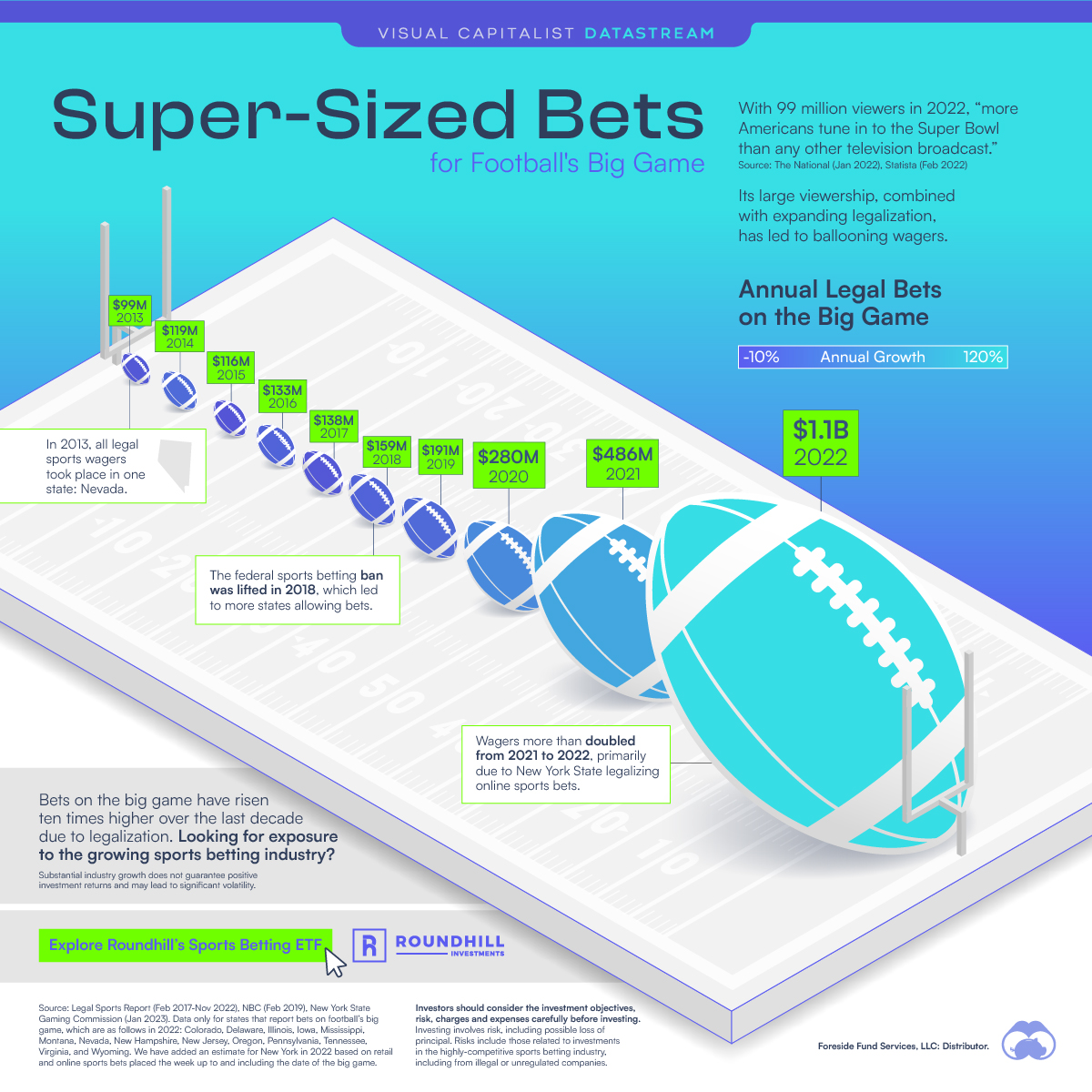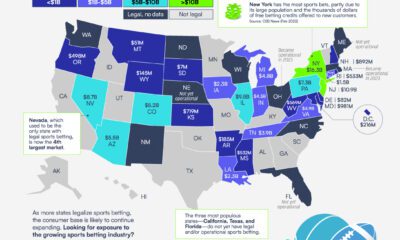Datastream
Super-Sized Bets for Football’s Big Game (2013-2022)
The following content is sponsored by Roundhill Investments.

The Briefing
- Sports betting became legal outside Nevada when the federal ban was lifted in 2018.
- Legalization contributed to betting growth, with wagers on football’s big game increasing ten-fold over the last decade.
Super-Sized Bets for Football’s Big Game
With 99 million viewers in 2022, “more Americans tune in to the Super Bowl than any other television broadcast.” Its large viewership, combined with expanding legislation, has led to ballooning wagers.
In this graphic sponsored by Roundhill Investments, we show how these bets have grown over the last 10 years.
Annual Legal Bets on the Big Game
From 2013 through 2018, sports betting was only legal in Nevada and year-over-year growth was low. However, when the federal sports betting ban was lifted in May 2018, more states started allowing bets.
By 2022, 33 states plus Washington, DC were legally able to bet on the game. Wagers climbed quickly as a result.
| Year | Total Bets | Annual Growth |
|---|---|---|
| 2013 | $99M | 5% |
| 2014 | $119M | 21% |
| 2015 | $116M | -3% |
| 2016 | $133M | 14% |
| 2017 | $138M | 4% |
| 2018 | $159M | 15% |
| 2019 | $191M | 20% |
| 2020 | $280M | 47% |
| 2021 | $486M | 73% |
| 2022 | $1.1B | 119% |
Data only for states that report bets on football’s big game, see graphic for full list of states included in 2022.
Impressively, legal bets surpassed the $1 billion mark in 2022. Growth was primarily driven by New York State legalizing online sports betting, with the state contributing nearly $500 million to the total.
Since the New York State Gaming Commission does not report event-specific totals, we have estimated this amount based on sports bets made the week leading up to and including the date of the big game.
Investment Exposure to an Emerging Industry
Due to legalization, bets on football’s big game have grown 10 times larger over the last decade. A further shift away from bookies and toward legal operators appears to be likely. In September 2022, 89% of Americans said it was important to bet with a legal operator this NFL season, up from 76% in February 2022.
For legal operators, this could translate into revenue opportunities. Companies that take legal bets reported more than $62 million in revenue from the big game alone in 2022, a 37% jump from the prior year.
Looking for exposure to the growing sports betting industry? Explore Roundhill’s sports betting ETF, $BETZ.
Datastream
Can You Calculate Your Daily Carbon Footprint?
Discover how the average person’s carbon footprint impacts the environment and learn how carbon credits can offset your carbon footprint.

The Briefing
- A person’s carbon footprint is substantial, with activities such as food consumption creating as much as 4,500 g of CO₂ emissions daily.
- By purchasing carbon credits from Carbon Streaming Corporation, you can offset your own emissions and fund positive climate action.
Your Everyday Carbon Footprint
While many large businesses and countries have committed to net-zero goals, it is essential to acknowledge that your everyday activities also contribute to global emissions.
In this graphic, sponsored by Carbon Streaming Corporation, we will explore how the choices we make and the products we use have a profound impact on our carbon footprint.
Carbon Emissions by Activity
Here are some of the daily activities and products of the average person and their carbon footprint, according to Clever Carbon.
| Household Activities & Products | CO2 Emissions (g) |
|---|---|
| 💡 Standard Light Bulb (100 watts, four hours) | 172 g |
| 📱 Mobile Phone Use (195 minutes per day)* | 189 g |
| 👕 Washing Machine (0.63 kWh) | 275 g |
| 🔥 Electric Oven (1.56 kWh) | 675 g |
| ♨️ Tumble Dryer (2.5 kWh) | 1,000 g |
| 🧻 Toilet Roll (2 ply) | 1,300 g |
| 🚿 Hot Shower (10 mins) | 2,000 g |
| 🚙 Daily Commute (one hour, by car) | 3,360 g |
| 🍽️ Average Daily Food Consumption (three meals of 600 calories) | 4,500 g |
| *Phone use based on yearly use of 69kg per the source, Reboxed | |
Your choice of transportation plays a crucial role in determining your carbon footprint. For instance, a 15 km daily commute to work on public transport generates an average of 1,464 g of CO₂ emissions. Compared to 3,360 g—twice the volume for a journey the same length by car.
By opting for more sustainable modes of transport, such as cycling, walking, or public transportation, you can significantly reduce your carbon footprint.
Addressing Your Carbon Footprint
One way to compensate for your emissions is by purchasing high-quality carbon credits.
Carbon credits are used to help fund projects that avoid, reduce or remove CO₂ emissions. This includes nature-based solutions such as reforestation and improved forest management, or technology-based solutions such as the production of biochar and carbon capture and storage (CCS).
While carbon credits offer a potential solution for individuals to help reduce global emissions, public awareness remains a significant challenge. A BCG-Patch survey revealed that only 34% of U.S. consumers are familiar with carbon credits, and only 3% have purchased them in the past.
About Carbon Streaming
By financing the creation or expansion of carbon projects, Carbon Streaming Corporation secures the rights to future carbon credits generated by these sustainable projects. You can then purchase these carbon credits to help fund climate solutions around the world and compensate for your own emissions.
Ready to get involved?
>> Learn more about purchasing carbon credits at Carbon Streaming
-

 Green1 week ago
Green1 week agoRanked: The Countries With the Most Air Pollution in 2023
-

 Automotive2 weeks ago
Automotive2 weeks agoAlmost Every EV Stock is Down After Q1 2024
-

 AI2 weeks ago
AI2 weeks agoThe Stock Performance of U.S. Chipmakers So Far in 2024
-

 Markets2 weeks ago
Markets2 weeks agoCharted: Big Four Market Share by S&P 500 Audits
-

 Real Estate2 weeks ago
Real Estate2 weeks agoRanked: The Most Valuable Housing Markets in America
-

 Money2 weeks ago
Money2 weeks agoWhich States Have the Highest Minimum Wage in America?
-

 AI2 weeks ago
AI2 weeks agoRanked: Semiconductor Companies by Industry Revenue Share
-

 Travel2 weeks ago
Travel2 weeks agoRanked: The World’s Top Flight Routes, by Revenue














